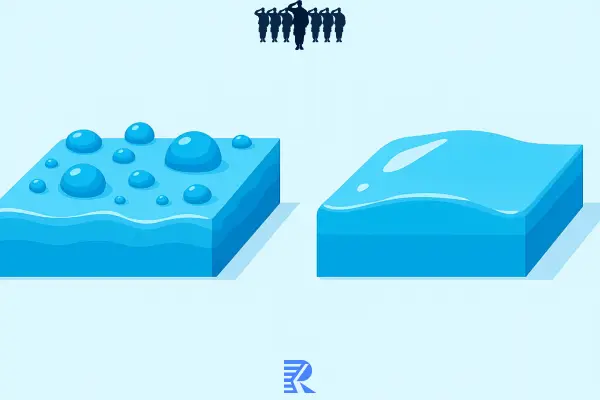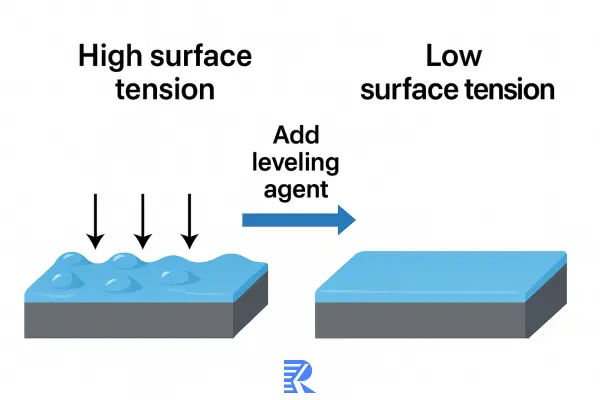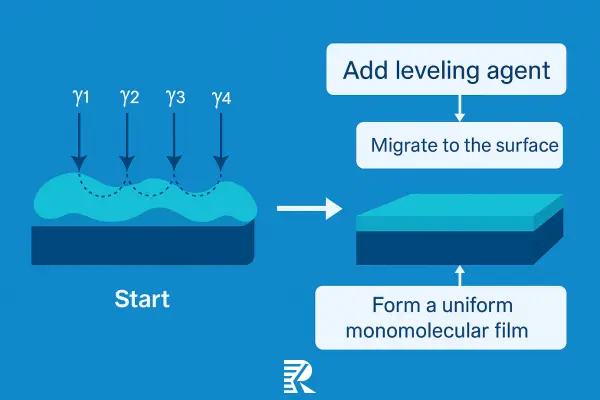Introduction
Ever wondered how paints achieve that perfectly smooth, glass-like finish? Or why some coatings flow beautifully while others leave brush marks or ‘orange peel’? Whether you’re working on automotive finishes, industrial coatings, or home DIY projects, leveling agents are essential to achieving a flawless surface.
In this comprehensive guide, we’ll explore the world of leveling agents—what they are, how they work, the different types, and why they’re indispensable in the coatings and inks industries. By the end, you’ll have a clear understanding of how these agents help eliminate common surface defects and improve the overall quality of coatings.

Quick Answer:
A leveling agent is a chemical additive used in coatings and inks to improve their flow and smoothness, preventing defects like brush marks and orange peel. It works by reducing surface tension, helping the coating spread evenly and level out during drying or curing.

What Exactly is a Leveling Agent?
A leveling agent is a surfactant-like compound that helps coatings, paints, and inks achieve a smoother, more uniform finish. It works by improving the flow and wetting properties of the liquid coating, which in turn reduces or eliminates common defects such as brush marks, orange peel, and craters.
Core Problem Solved: Leveling agents are most commonly used to prevent imperfections in the surface finish of coatings. These defects occur when the liquid coating fails to spread evenly across the surface, leading to unsightly marks. For example:
- Orange Peel: A bumpy texture resembling the skin of an orange.
- Brush Marks: Streaks left by the brush or applicator.
- Cratering and Pinholes: Small depressions or holes that appear as the coating dries.
Think of leveling agents like a small amount of soap in water. Just as soap helps water spread more evenly over a surface instead of beading up, a leveling agent helps a coating spread smoothly and uniformly.

How Do Leveling Agents Work? (The Mechanism)
At its core, a leveling agent reduces surface tension, which allows the coating to spread more easily across the substrate. Here’s how it works:
- Surface Tension Focus: When applying a coating, the liquid tends to bead up due to surface tension. Leveling agents reduce these surface tension gradients, helping the liquid spread more evenly.
- Surface Migration: Some leveling agents migrate to the surface during the drying or curing process, helping the coating achieve a smooth, uniform finish.
- Molecular Structure: Many leveling agents act like surfactants, with hydrophilic (water-attracting) and hydrophobic (water-repelling) parts. This structure helps the agent migrate to the surface and reduce surface tension.

Visual Aid #1: Surface Tension Comparison
A diagram showing how leveling agents help even out high vs. low surface tension during the drying process.
Key Functions and Benefits
Improved Flow and Leveling
The primary function of leveling agents is to enhance the flow of coatings and inks, ensuring they spread smoothly and evenly over the substrate.
Defect Prevention
Leveling agents help eliminate surface defects such as:
- Orange Peel
- Brush Marks
- Cratering
- Pinholes
Enhanced Wetting
Leveling agents improve the wetting properties of coatings, allowing them to spread more uniformly across various substrates, from wood to metal.
Gloss Improvement
By ensuring a smoother surface, leveling agents help achieve a higher gloss finish, making surfaces appear shinier and more polished.
Reduced Air Entrapment
Some leveling agents can help release air trapped in the coating, reducing bubbles or foam formation during application.
Surface Slip
Certain types of leveling agents can provide a slight surface slip, which can help with easier application and flow.
Major Types of Leveling Agents
Leveling agents come in various formulations, each with its own benefits and drawbacks. Let’s take a closer look at the most common types.
Silicone-Based Leveling Agents
- Examples: Polydimethylsiloxanes (PDMS), Polyether-modified, Polyester-modified.
- Pros: Highly effective at improving leveling, provides slip and reduced drag, widely used in industrial and automotive applications.
- Cons: Can cause cratering if overused, and may create issues with recoatability.
Acrylic-Based Leveling Agents
- Examples: Polyacrylates.
- Pros: Good leveling properties with fewer issues like cratering. Better recoatability compared to silicones.
- Cons: Less effective than silicone-based agents in some cases, especially in low-viscosity systems.
Fluorosurfactant-Based Leveling Agents
- Examples: Perfluorooctyltrichlorosilane (PFOTS).
- Pros: Extremely effective even at low concentrations, ideal for tough systems like high-performance coatings.
- Cons: High cost and environmental concerns, particularly with PFAS chemicals.
Non-Ionic Surfactants
- Examples: Certain ethoxylated surfactants.
- Pros: Used for wetting and leveling, effective in both water-based and solvent-based systems.
- Cons: Less potent than other types and may require higher dosages.
Other Types
In addition to the above, some newer formulations and hybrid agents are used to meet specific application needs, such as those designed for UV-cured coatings or specialized industrial applications.
| Type of Leveling Agent | Effectiveness | Cost | Recoatability | Potential Issues |
|---|---|---|---|---|
| Silicone-Based | Very High | Moderate | Can be problematic | Cratering, poor intercoat adhesion if overused |
| Acrylic-Based | Moderate to High | Low to Moderate | Good | Less potent than silicone in some systems |
| Fluorosurfactant-Based | Extremely High | High | Good | High cost, environmental concerns (PFAS) |
| Non-Ionic Surfactants | Moderate | Low | Good | May require higher dosage |
Visual Aid #2: Comparison Table
A simple table comparing the main types of leveling agents, including effectiveness, cost, recoatability, and potential issues.
Where Are Leveling Agents Used?
Leveling agents have broad applications across multiple industries. Some of the most common uses include:
- Coatings: Automotive paints, architectural finishes, industrial coatings, wood finishes, and varnishes.
- Inks: Offset, flexo, gravure printing inks, and inkjet inks.
- Adhesives & Sealants: Ensuring smooth application and effective film formation.
- Textile Finishing: Used in dyeing processes to ensure even color uptake.
- Plastics & Polymers: As processing aids to improve surface smoothness and appearance.
- Construction Chemicals: Self-leveling compounds and concrete admixtures.
- Agriculture: In pesticide formulations, helping the spray spread more evenly.
- Personal Care: In products like nail polish and certain lotions, although less common.
Factors for Selecting the Right Leveling Agent
When selecting a leveling agent, consider the following factors:
- The System: Is your coating water-based, solvent-based, powder, or UV-cured?
- Substrate Compatibility: Ensure the agent is compatible with the material being coated (wood, metal, plastic, etc.).
- Defect Type: Choose an agent that addresses the specific defect you’re aiming to eliminate.
- Dosage Efficiency: Some agents work better in small quantities, while others may require higher dosages.
- Compatibility with Other Ingredients: Make sure the leveling agent works well with other additives in the formulation.
- Regulatory Requirements: Consider VOC content and any environmental or regulatory constraints.
- Cost: Assess cost-effectiveness based on the performance requirements.
Potential Considerations & Limitations
While leveling agents are indispensable, they aren’t without limitations:
- Over-addition: Adding too much can cause defects like crawling or cratering.
- Compatibility Issues: Some leveling agents may not work well with certain resins or binders.
- Impact on Other Properties: Too much leveling agent can affect intercoat adhesion and long-term durability.
- Environmental Concerns: Fluorosurfactants (e.g., PFAS) can raise environmental and regulatory issues due to their persistence in the environment.
FAQ Section
Q: Is a leveling agent the same as a flow agent?
A: The terms are often used interchangeably, but there is a subtle difference. Flow agents typically help the coating flow smoothly, while leveling agents focus on reducing defects like orange peel.
Q: How much leveling agent should I use?
A: The amount varies depending on the system and the specific leveling agent. Always follow the manufacturer’s recommendations for best results.
Q: Can leveling agents fix all surface problems?
A: No, surface preparation is also key. Leveling agents can’t fix problems caused by poor surface preparation or contamination.
Q: Are leveling agents toxic?
A: It depends on the type. Always refer to the Safety Data Sheet (SDS) for the specific leveling agent to determine its toxicity and handling requirements.
Q: What causes orange peel in paint?
A: Orange peel occurs when the coating doesn’t flow evenly during application, often due to high viscosity or inadequate surface preparation.
Conclusion & Key Takeaways
Leveling agents are vital for ensuring smooth, defect-free finishes in coatings and inks. By understanding their function, types, and applications, you can choose the right agent for your needs, whether you’re working on automotive paints, industrial coatings, or adhesives. Remember, selecting the right leveling agent can be the difference between a flawless finish and an imperfect one.
